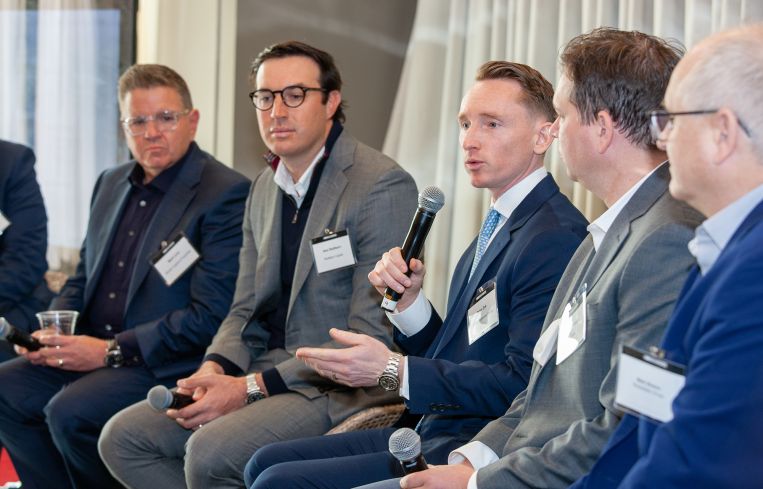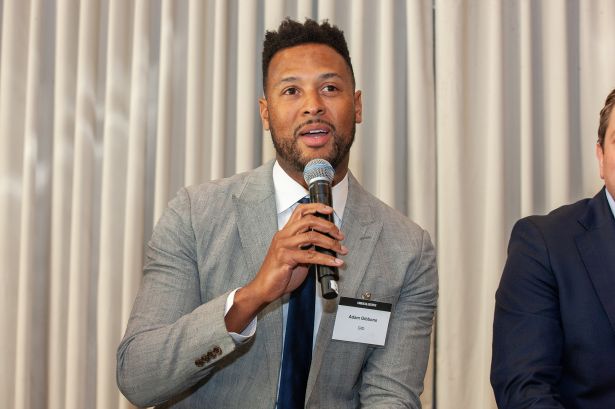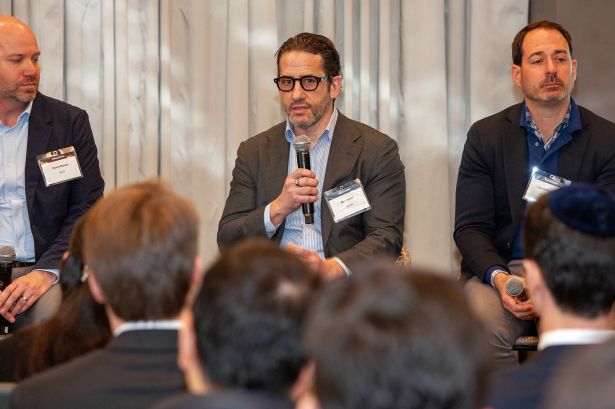Industrial Players Go Long on Long-Term Amid Tariffs, Other Uncertainty
A recent Commercial Observer forum quizzed owners, lenders and advisors about what’s ahead in the once-hot asset class
By Amanda Schiavo April 10, 2025 12:58 pm
reprints
Industrial real estate — warehouses, manufacturing facilities, distribution centers, logistics hubs and outdoor storage — boomed as an asset class during the pandemic lockdowns. Its allure for investors has since cooled a bit, but demand is still very much there.
The main drivers of that demand include a booming e-commerce market, regionalization, a shift in globalization, and consumer spending, according to research from real estate investment firm Clarion Partners.
These factors were among the drivers that panelists and other attendees at Commercial Observer’s April 9 National Industrial Forum discussed throughout the morning at the Royalton Park Avenue Hotel. The forum brought together leaders from the industrial real estate space who discussed how the industry is faring in the currently frenetic national economic and political environment.
The day kicked off with a panel on trends and opportunities within the space.
The speakers for the first session were Tom Griggs, a managing director at owner Hines; Alex Redfearn founder, president and CEO of Redfearn Capital; Peter Zuk, head of asset management for North American industrial at Oxford Properties Group; Mark Levy, president of Altman Logistics Properties; Mark Shearer, senior managing director at owner Rockefeller Group; and David Kupfer, a partner with law firm King & Spalding.
The panel discussed the impact of macroeconomic trends, tariffs and market uncertainty on the industrial sector. President Donald Trump’s recent wave of global trade tariffs, of course, were the biggest topic of discussion. (The forum wrapped just before Trump paused most tariff hikes on most countries.)
“It’s hard to know exactly what’s happening with the president,” Redfearn said. “A lot of it is posturing. It feels like a lot of it will come off. It’s hard to underwrite that. But uncertainty is tough for tenants. It’s tough for landlords. It’s tough for everybody who’s trying to make a decision.”
Uncertainty appeared to be the word of the day during the forum as attendees noted their clients and partners taking more of a wait-and-see approach given the market volatility.

“One of the things we heard in 2024 across the brokerage community was ‘survive to `25,’ and `25 is here and it’s not looking so great,” Zuk said. “We’re long-term investors. We see through administrations, and, so as fast as this comes, it may go away, but you are seeing an immediate impact.”
Zuk noted that leasing demand is down and users in the market are “effectively paused.” As they take the time to understand what is going on, the industry is left wondering when prospective tenants will make a decision.
“Decisions are just taking longer to make,” Griggs said. “I think that’s really been a trend for well over a year. But from a fundamental perspective, it’s difficult to design your supply chain in a market that’s this volatile. Supply chains have been built out over years, and in some cases decades, and they just don’t adapt that quickly.”
As an investor and an owner, Griggs — and the other panelists — is taking a slow and steady approach, focusing on the long-term investments and not taking a quick sell on the latest news.
One area seeing the immediate impact of Trump’s tariffs is construction pricing, Levy said. And that is causing real concern.
“We just sort of got through a very disruptive period of time due to supply chain issues brought about by COVID,” he continued. “We’re now entering a situation where general contractors are giving us tariff allowances, and are not willing to price a number of components of construction. So it’s really going to be a challenging world for us to be able to really understand how to underwrite new development when we don’t have any clarity as to what construction costs are going to end up being.”
The impact of tariffs on construction lending was a key topic during the next panel, which focused on financing industrial deals.
The speakers were Abbe Franchot Borok, managing director and head of U.S. debt at owner and investor BGO; Drew Fung, managing director and fund portfolio manager for debt for Clarion Partners; Kevin Neveloff, chief legal officer and executive vice president of business affairs for Big Watt Digital; Andrew Chana, CEO, senior managing partner and co-founder of advisory Piermont; and Adam Gibbons, co-head and chief investment officer for GID Credit.
The speakers on the second panel echoed the theme of focusing on two to three years down the line and just riding out the short-term storm.
“So, in construction lending, it’s almost a little bit easier to block out some of the near-term noise,” Gibbons said. “We try not to overreact to what happens today, what happens tomorrow, what’s happening this week, and taking more of a long-term view.”
He noted that you can’t ignore the impact that news like the tariffs has on the entire industrial sector — leasing demand, costs of construction, et cetera — but that it should be driving decisions that will pay off in the longer-term.
“But the way we structure any construction loan is we’re looking three years out into the future,” Gibbons said. “We’re trying to see in a picture of what the market looks like when the asset delivers.”
Prior to the (latest) tariff announcements, the construction lending market was more favorable, Fung noted, as lenders were offering more attractive terms. Now there is a pause among many lenders. Looking ahead two to three years, there might be a short-term increase in demand for warehouse space due to manufacturers building up inventories, he continued. However, the overall uncertainty is making it difficult to predict future developments.
Moving into a more niche segment of the industrial space, the panelists for the final session of the day focused on industrial outdoor storage (IOS) and its close cousin cold storage.
The speakers were Leo Addimando, co-founder and CEO of Alterra Property Group; Ben Atkins, co-founder and CEO of Zenith IOS; Kevin Rivest, managing partner, portfolio manager and head of U.S. cold storage at BGO; and Justin Horowitz, debt and equity adviser at owner Cooper Horowitz.

During the discussion these experts shared insights into how they’re navigating these specific niches, given all of the — yes — uncertainty in the air right now. Atkins noted that not everyone actually understands what IOS is unless they are directly involved.
“People who don’t understand IOS will oftentimes think of it as industrial land or as truck parking, which is also erroneous,” he said. “When I think of what we’re doing and what we’re building, we are urban infill, industrial yard landlords. We look for low-coverage, industrial sites where we can service a mission-critical tenant pool that supplies various aspects of the U.S. supply chain.”
The idea that IOS was covered land was how most investors looked at the industry, Addimando noted.
“Up until more recently, a lot of the capital markets players looked at it [that way],” he said. “Nobody likes covered land, not after the [Global Financial Crisis]. We like to think of the asset classes being 10 percent of the entire industrial asset base. Any industrial zone property where you can lay things outside, by right, not as an ancillary use that’s 2 acres or more that has less than 25 percent of the ground covered by building falls into the IOS category.”
Despite the lack of knowledge around cold storage and IOS, they are still key to the overall health of the industry. The panelists agreed that the long-term fundamentals are strong — whatever the current uncertainty.
Amanda Schiavo can be reached at aschiavo@commercialobserver.com.


